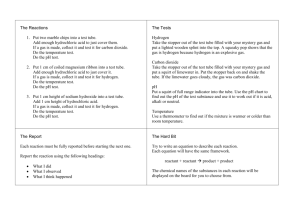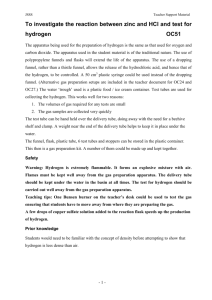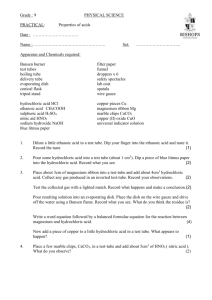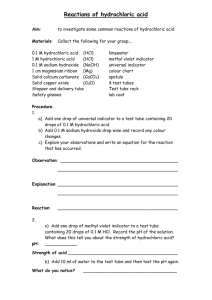Formal Lab Reports
advertisement
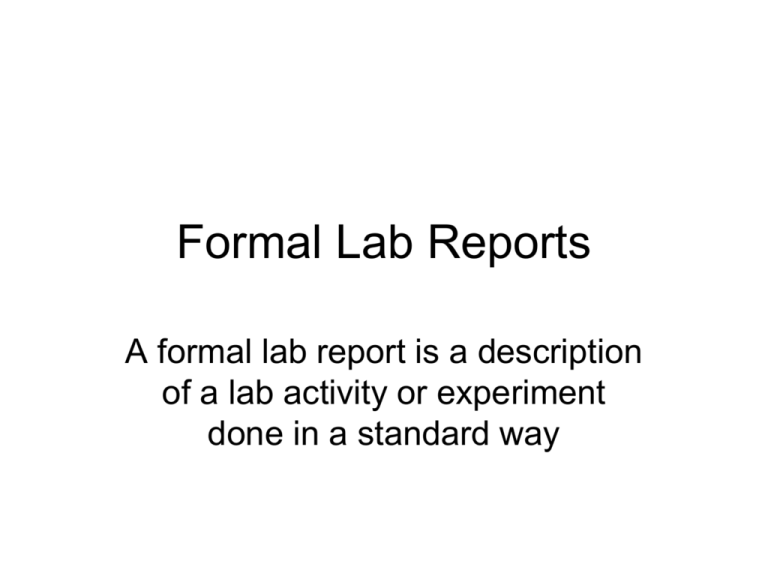
Formal Lab Reports A formal lab report is a description of a lab activity or experiment done in a standard way A formal lab report should include: • • • • Your name, first and last The date you finished the experiment A title for the experiment The purpose (or aim or hypothesis) – A sentence that describes what the experiment was intended to show, demonstrate or prove. • The materials – A list of the equipment and materials you used • A procedure – Describe the steps you followed in their correct order. When writing your own procedure the past impersonal (passive voice) is preferred. If you are following a procedure from a handout or book you may make a reference to it in a sentence, rather than copying the whole thing. • A diagram (unless otherwise told) – Sketch a neat diagram to illustrate how you set up the experiment, if required. If you draw the diagram yourself, use a ruler and pencil, do it neatly and label the equipment. You may also use a chemistry stencil to help you. Sometimes you can find drawings of chemistry equipment on the internet (but if you use internet sources, list their URL at the end of the lab). I also have a file of chemistry clip-art available. • Observations: – There are two different types of observations. Some labs have one type, some have the other, some have both. • Qualitative Observations should be recorded in sentences, eg. “when the two solutions were mixed a yellow precipitate formed”, or “when the sodium was placed in water it bubbled for a few seconds and then there was a small explosion.” • Quantitative Observations (or Data) should be recorded in lists or tables, including the measurements and units. • Calculations: – if required, show what you did with the data in order to get your conclusions. • Sometimes you are required to draw a graph of your data in this section. • Conclusion: – The conclusion consists of one or two sentences that state what you found out, and if you have succeeded in demonstrating what you recorded as your purpose. If your purpose required you to find a specific numerical answer, give a measure of your success (such as %error or %accuracy). • Discussion: – A few paragraphs in which you give background information about the lab, including any research you did about the subject matter. If there was a chemical reaction involved, give a balanced equation. You may also describe difficulties your encountered and sources of error that may have affected your results. This section is yours, and yours alone. NEVER copy your partner’s discussion (both partners would lose marks). In this section you must convince me that you fully understand what the experiment is about. Eli McStone September 15, 2011 Rate of Production of Hydrogen Gas Purpose: To measure the rate at which hydrogen gas is produced by the reaction of zinc and hydrochloric acid. Materials: Flask, 1mol/L hydrochloric acid, mossy zinc, two-hole stopper containing glass tube and thermometer, rubber tubing, displacement tray, graduated test tube, clock. Procedure: A graduated test tube was filled with water and inverted in a displacement tray. 20g of zinc was added to a flask containing 100mL of 1mol/L hydrochloric acid. The flask was sealed with a stopper that had a bent glass tube and thermometer inserted through it. A rubber tube was connected to the glass tube, and the other end placed under the graduated test tube in the displacement tray. The amount of hydrogen gas collected was measured every ten seconds until the test tube was filled. Diagram: Observations (Qualitative): When the mossy zinc was placed into the hydrochloric acid, it began to bubble rapidly, which forced gas through the rubber tubing until it began to bubble up inside the test tube. Observations : (Data) Time Volume Time Volume 10 sec 7 mL 30 sec 20 mL 20 sec 15 mL 40 sec 28 mL Calculations: The production of hydrogen gas was graphed below. The rate appears to be linear with a few minor deviations, so the average rate of production was found by dividing rise over run: Rate = 28mL = 0.70mL/sec 40sec Conclusion: The average rate of production of hydrogen was 0.7 mL per second. Discussion: In this lab we used the reaction of zinc and hydrochloric acid: 2Zn + 2HCl 2ZnCl +H2 to produce hydrogen gas. During our experiment it appeared that the rate of production was constant, producing a linear graph, but subsequent research shows that the reaction rate should eventually slow down as the concentration of the hydrochloric acid decreases. It is possible that timing the reaction for only forty seconds resulted in the more linear rate, or perhaps the concentration of HCl was so high that any slowing of the rate was negligible. (for a top-level mark, you could continue the discussion giving more information about rates of reaction, eg. What other factors may have influenced the rate, what order of reaction rate you expected, etc.)
